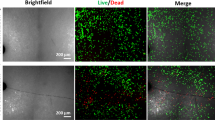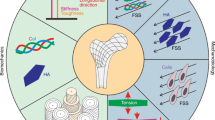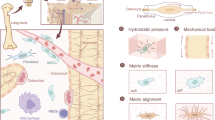Abstract
FUKADA and Yasuda1 showed that dry bone is piezoelectric in the classic sense, that is, mechanical stress produces polarisation (direct effect) and application of an electric field produces strain (converse effect)2. The possibility that the mechanism for osteogenesis is electrical3 has aroused interest in an investigation of such effects in the more nearly physiological condition represented by wet bone. Recent developments in electrical stimulation of fracture healing4,5 have further emphasised the importance of characterising the piezoelectric properties of wet bone. As the piezoelectricity of wet collagen6 decreases to zero at a moisture content equal to 45% of the dry weight (which corresponds to almost 100% humidity)7, there is some doubt as to whether wet bone could be piezoelectric. Observations of voltages in wet bone under stress, have been made under conditions giving such ambiguous results that they suggested alternative concepts to that of classic piezoelectricity8–11. In view of the confusion about the nature of the voltage developed when wet bone is stressed, we have used a simple longitudinal stress system with sinusoidally varying drive, to measure both converse and direct piezoelectric coefficients of bone as functions of humidity (and ultimately of moisture content). The results show unambiguously that wet bone behaves as a piezoelectric material.
This is a preview of subscription content, access via your institution
Access options
Subscribe to this journal
Receive 51 print issues and online access
$199.00 per year
only $3.90 per issue
Buy this article
- Purchase on Springer Link
- Instant access to full article PDF
Prices may be subject to local taxes which are calculated during checkout
Similar content being viewed by others
References
Fukada, E., and Yasuda, I., J. phys. Soc. Japan, 12, 1158–1162 (1957).
Cady, W. G., Piezoelectricity, 1, 183 (Dover, New York 1964).
Bassett, C. A. L., Calc. Tiss. Res., 1, 252–272 (1968).
Lavine, L. S., Lustrin, I., Shamos, M. H., Rinaldi, R. A., and Liboff, A. R., Science, 175, 1118–1121 (1972).
Bassett, C. A. L., Pawluk, R. J., and Pilla, A. A., Science, 184, 575–577 (1974).
Fukada, E., and Yasuda, I., J. appl. Phys., 3, 117–121 (1964).
Bull, H. B., J. Am. chem. Soc., 66, 1499–1507 (1944).
Cochran, G. V. B., Pawluk, R. J., and Bassett, C. A. L., Clin. orthoped. rel. Res., 58, 249–270 (1968).
Anderson, J. C., and Eriksson, C., Nature, 218, 166–168 (1968); 227, 491–492 (1970).
Becker, R. O., Bassett, C. A. L., and Bachman, C. H., in Bone biodynamics (edit. by Frost, H. M.), 209–231 (Little, Brown, Boston, 1964).
Black, J., thesis, Univ. Pennsylvania (1972).
Fukada, E., J. phys. Soc. Japan, 10, 149–154 (1955).
Reinish, G. B., thesis, Univ. Columbia (1974).
Marino, A. A., and Becker, R. O., Nature, 253, 627–628 (1975).
Author information
Authors and Affiliations
Rights and permissions
About this article
Cite this article
REINISH, G., NOWICK, A. Piezoelectric properties of bone as functions of moisture content. Nature 253, 626–627 (1975). https://doi.org/10.1038/253626a0
Received:
Published:
Issue Date:
DOI: https://doi.org/10.1038/253626a0
This article is cited by
-
Self-promoted electroactive biomimetic mineralized scaffolds for bacteria-infected bone regeneration
Nature Communications (2023)
-
Sensing of Physical Factors by Cells: Electric Field, Mechanical Forces, Physical Plasma and Light—Importance for Tissue Regeneration
Biomedical Materials & Devices (2023)
-
Osteogenesis Modulation: Induction of Mandibular Bone Growth in Adults by Electrical Field for Aesthetic Purposes
Aesthetic Plastic Surgery (2022)
-
Poromicromechanics reveals that physiological bone strains induce osteocyte-stimulating lacunar pressure
Biomechanics and Modeling in Mechanobiology (2016)
-
A Multiscale Theoretical Investigation of Electric Measurements in Living Bone
Bulletin of Mathematical Biology (2011)
Comments
By submitting a comment you agree to abide by our Terms and Community Guidelines. If you find something abusive or that does not comply with our terms or guidelines please flag it as inappropriate.



